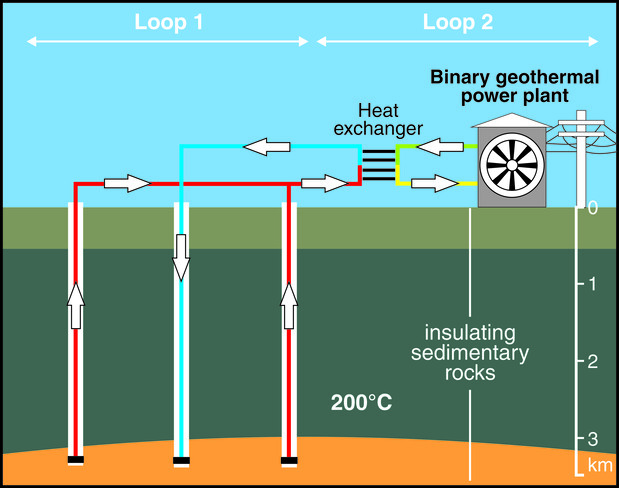Geothermal energy is a low emission alternative energy source to traditional fossil fuels. Geothermal energy resources are administered under the Petroleum and Geothermal Resources Act 1967 and all current exploration titles are landward of the coastline.
Geothermal energy can be exploited in various Western Australian regions in a number of ways, depending on the density of industrial, commercial and domestic markets. Geothermal explorers are directing their interests not only towards electricity generation, but also low temperature heat-energy applications such as air conditioning, pool heating and agriculture. Presently there is no commercial production of geothermal energy in Western Australia.
The premises for geothermal energy in Western Australia

Geothermal energy is governed by the intended use of the energy and type of development planned for its exploitation. The premises for geothermal energy are, therefore, both technical and economic. Each of the three main types of geothermal development is linked to a specific temperature depth range. The three main types of geothermal developments are:
- hot dry rock
- hot aquifer or hydrothermal
- shallow heat pumps or heat exchangers
Geothermal heat sources, in terms of ambient rock temperature that are relevant for energy usage, fall into the following three classes:
- low temperature heat sources with temperatures less than 60 degrees celsius, used in air conditioning, pool heating and agriculture
- hot aquifer or hydrothermal heat sources with temperatures from 80 to 250 degrees celsius, used in low efficiency electricity generation and industrial heating systems
- high temperature heat or hot dry rock and volcanic sources with temperatures greater than 250 degrees celsius, used in electricity generation
Economic considerations come into play when one balances the amount of thermal energy extraction estimations with access costs and conversion mechanisms.
Geothermal prospectivity
Western Australia possesses low to medium temperature geothermal resources that can be exploited to provide moderate levels of electrical power and low-temperature heat energy applications. Of the major sedimentary basins that are prospective for geothermal energy, the onshore Northern and Southern Carnarvon Basins appear to possess greater temperatures in the upper 1,500 metres of the sedimentary succession than the Perth and Canning Basins.
The Perth Basin, where the major population centres in Western Australia are located, encompasses the major energy demand in the State. Exploration for, and implementation of, geothermal energy in this Basin is advantageous for future domestic energy supply.
The Northern and Southern Carnarvon Basins appear to be warmer than the Perth Basin and, in terms of potential geothermal usage, shallow low temperature geothermal applications may be attractive for specific industrial applications or community heating and cooling. Generation of electricity through combinations of Organic Rankin Cycle turbines or combined geothermal and solar energy may be attractive also for small communities or mining centres.
The Canning Basin is remote in terms of population and infrastructure. Nevertheless, geothermal energy may be attractive to produce electricity for small communities, cattle stations, agricultural industries and other activities in the region. Solar-supplemented geothermal energy is a viable energy source for small electricity generation plants of 10 to 20 kilowatts, based on Organic Rankin Cycle turbines.
Geological setting, exploration history and geothermal prospectivity for each of the major Basins can be found in the Western Australia’s petroleum and geothermal explorer’s guide .
Major prospective sedimentary basins for geothermal energy
The main prospective basins in Western Australia are:
Technology considerations

Technological advances, especially in the improved efficiency of Organic Rankin Cycle turbines and heat pipes, may render much of the Perth Basin and some areas in the Canning Basin amenable to economic geothermal energy developments.
Organic Rankin Cycle turbines
Geothermal resources in many regions in Western Australia are probably best developed in terms of electrical power generation with the use of Organic Rankin Cycle turbines.
Conventional steam turbines operate most efficiently when the source temperature is about 350 degrees celsius, and will not work for the relatively low temperatures encountered in hot aquifer geothermal regions. In Western Australia, it is expensive to drill to depths where temperatures of 300 to 350 degrees celsius are encountered. Accordingly, to convert thermal energy into electricity, many geothermal energy projects make use of Organic Rankin Cycle technology, which becomes applicable when the source temperature is over 90 degrees celsius. The trade-off of being able to use this technology versus conventional dry-steam technology is a loss in conversion efficiency from thermal energy to electrical energy.
For more information read Organic Rankin Cycle turbines (page 68).
Heat Pipes
A heat pipe is a heat-transfer mechanism that can transport large quantities of heat with a very small difference in temperature between hotter and colder regions. Inside the heat pipe, a hot region converts a liquid (working fluid) to vapour, and the gas flows naturally towards the cold region, where it condenses. The liquid flows by capillary action back to the hot region, where the process commences again.
It has been suggested a heat pipe may be applied to geothermal energy extraction. The technological innovation of a heat pipe is that relatively large amounts of heat may be extracted from a single borehole or well, as the heat pipe contains both the upward and downward flow of the working fluid. This technology possesses two strong advantages. The first is removing the need for separate extraction and injection wells. The second is the elimination of flowing a deep aquifer to the surface, as the heat is transferred by a closed circuit working fluid within the heat pipe.
Find out more about Heat pipes (page 68).
Further information including publications on geothermal resources can be obtained on the Geological Survey of WA geothermal energy page.
